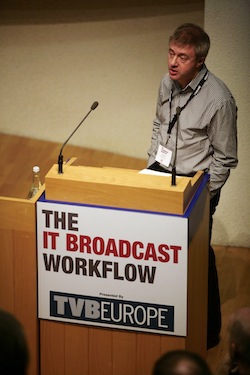
In July 2008 Channel 4 announced the outsourcing of its broadcast and production services. Analysis of the migration from Shane Tucker, technical architect Channel 4 and Ian Wimsett, senior technologist, Red Bee Media.
When Channel 4 decided to outsource its broadcast and production services to Red Bee Media, it meant a complex relocation, across London, of its many services, while maintaining integration with its existing business systems back at HQ.
“We started looking at this in August, 2008, when Channel 4 decided to outsource playout of 27 variants (including regional opt outs and +1 services) of C4, More 4, E4 and Film 4,” said Ian Wimsett, Red Bee’s senior technologist. This included post production (for promos and reversioning), media services, library, MCR, VoD, and interactive.
One of its key migration requirements was “to have minimal impact on the business.” This required an extensive period of testing and they wanted to minimise tape traffic between the sites during parallel operations, added Shane Tucker, Technical Architect, Channel 4.
Channel 4 already had a large automated workflow using its own in-house Pirate system to manage programmes from the tracking of initial proposals through rights management, planning, media management, down to the control of the ingest of SD content to a DAM.
Red Bee already delivers some 120 TV streams on analogue, DTT, satellite, cable, web and mobile, with about 25,000 IT file transactions every day, on all of its customer’s services, so the project wasn’t particularly big, but it was demanding. “It’s quite a complex systems integration project,” said Wimsett.
Channel 4’s primary business objectives were “cost savings by outsourcing” and a technology partnership with a company that was more specialised and had more depth of resource than Channel 4, according to David Dorans, C4’s head of distribution and broadcast technology.
It also had to “keep us competitive as digital technology transforms broadcasting,” added Anne Bulford, its group finance director.
It laid down certain design principles: minimum impact to Channel 4 business systems; minimise technical space at its HQ (it retained editorial space, but it didn’t want much else); use a service oriented approach without relying on single providers for systems; use published standards for content and data; and use standard IT components. “The solution had to be file based, where possible, but there was still an element of tape in workflows, because Channel 4’s existing archive is tape-based,” said Wimsett.
At Channel 4, browse has its own MAM, and Pirate now has a web services interface to integrate with the rest of the systems. It creates both HD and SD versions after ingest and QC. Most commercials come in as files, and there is a large StorNext SAN and then a data tape for archive. There is a separate Cordis workflow engine that uses web services to communicate.
It is fundamentally HD throughout, with SD playout where necessary. It uses MXF for content files at 50Mbps (IMX) for SD and DNxHD (185Mbps) for HD.
Quality Control is done automatically using Cerify, with a flash pattern recogniser reporting to the regulator, OFCOM.
Information is exchanged from Pirate via BXF (Broadcast eXchange Format – a standard published in 2008 to standardise metadata), which is very good for sending data between broadcast business systems, such as scheduling, DAM and playout. Red Bee built a BXF schedule authority with Snell and VizRT, and is a member of the Advanced Media Workflow Association (www.amwa.tv), which hopes to drive the specifications for networked media flows, such as interoperability between AAF, BXF, MXF and XML.
There are DAM systems in both locations (a smaller version at C4), which talks to Avid systems via Interplay. Dual dedicated 10Gbps circuits connect both sites.
Most of Channel 4’s services have migrated to Red Bee — the last channel (C4 itself) moved on December 1. It now has a small, in-house team of Cordis experts to do its own development and make sure it continues to work with new services. The VizRT DAM works well with web services.
“The workflows are quite complicated. We didn’t have enough time to do workflow analysis, which made it more costly, as we had to have the ability to change it easily,” said Wimsett.
“You have to cope with all the things that go wrong and have to deal with it in the design rather than throwing people at it in the workflow,” he advises. “It’s quite difficult to get a consistent user experience, because you’re integrating lots of systems together, which is why a lot of our workflow goes back to the web interface and only brings the user into the specialised DAM interface, etc., when necessary.”
He finds that “the engineers we are getting today are very much more IT-based than broadcast,” but quickly get the message that you cannot use very expensive components and it can’t take time. He is also now seeing broadcast engineers that are very good at IT. “I think the two areas are very much converging, but not as quickly as maybe we though they would two or three years ago, because one person can’t specialise so much so quickly.”
Training is also an issue – 110 people moved across from C4 to Red Bee. “We had to do an awful lot of training, which is still going on. But, the basics of QC or ingest remain the same.”
Channel 4 didn’t want to do this in-house, because of cost, and believes it has saved 10-15% by outsourcing. “The business case stands up if you do it over the right term. You won’t get a return on investment in two years,” said Tucker. – David Fox





